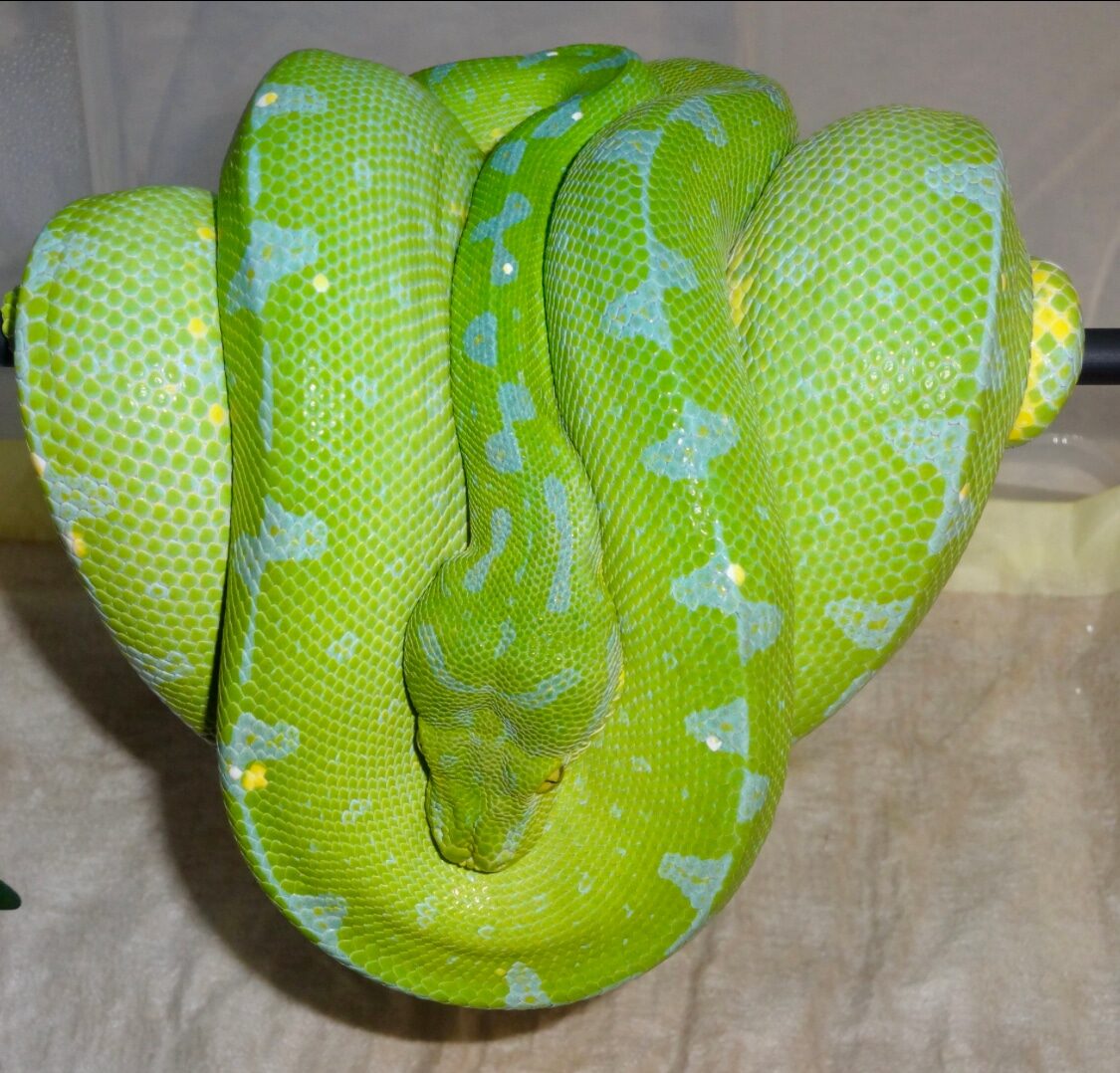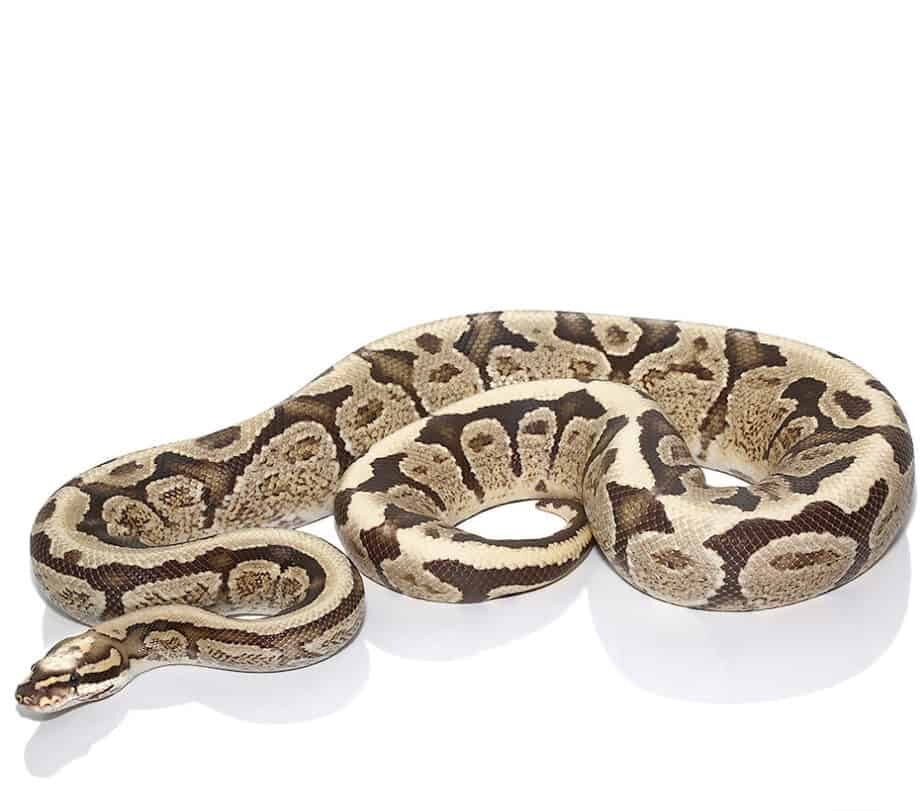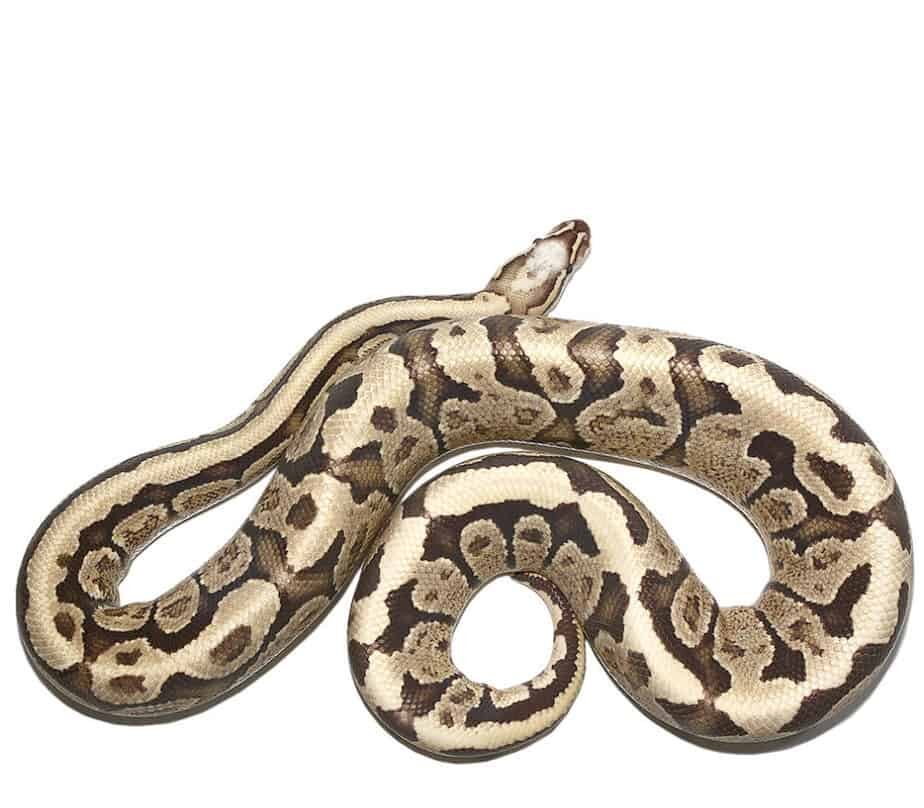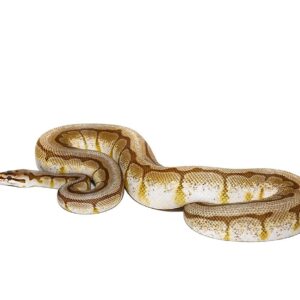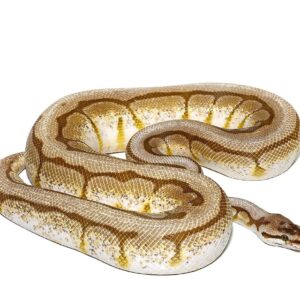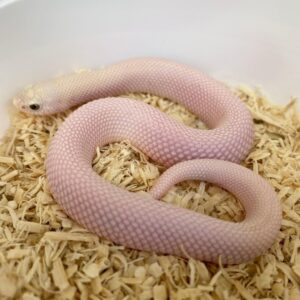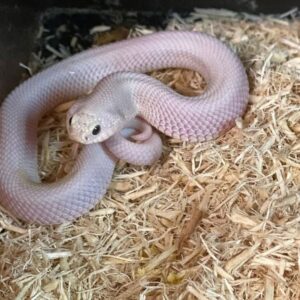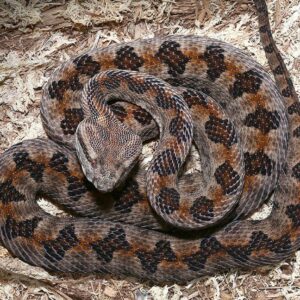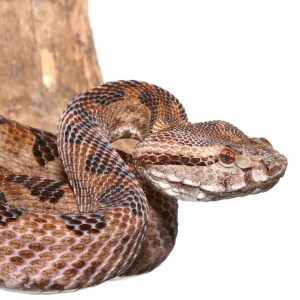Super Vanilla Ball Python
$299.99
WE HAVE A SUPER VANILLA BALL PYTHON FOR SALE. HERE ARE SOME HIGHLIGHTS:
- Python regius
- Captive Bred
- Approximately 45 Inches In Length
- Roughly 1322 Grams And Growing
- When Hatching Out Of The Egg They Can Be As Small As 10 Inches And Grow To Be 5 Feet
- Feeding On Live Adult Mice Weekly
FUN FACTS!
- These Snakes Are Brilliantly Colored With Gold’s, Browns, And Black Patterns From Head To Tail
- Ball Pythons Are Native To Central And Western Africa And Thrive In These Warm, Tropical Areas
- Great For A First Time Keeper As Well As An Experienced Breeder
- With Proper Care And Setup These Snakes Can Live 20 – 25 Years In Captivity
Description
The Super Vanilla Ball Python is a remarkable morph within the ball python species, celebrated for its distinctive appearance and genetic composition. Unlike the standard ball python, the Super Vanilla exhibits a unique blend of colors and patterns, resulting from the homozygous form of the Vanilla gene. This genetic background contributes to its striking visuals, characterized by a lighter, creamier coloration and a reduced pattern that sets it apart from other morphs.
The Super Vanilla Ball Python’s appeal lies not only in its aesthetics but also in its genetic simplicity. Being a homozygous morph, it is produced by breeding two Vanilla Ball Pythons together, making it a straightforward and enticing option for breeders. The consistency in producing visually appealing offspring adds to its popularity among both novice and experienced reptile enthusiasts.
In terms of physical characteristics, the Super Vanilla Ball Python typically showcases a pale yellow or cream base color, with a noticeable reduction in dark pigmentation. This gives the snake a smoother and more uniform appearance, which is highly sought after in the reptile community. Additionally, the morph often exhibits a cleaner, more defined pattern compared to other ball python morphs, further enhancing its visual appeal.
The popularity of the Super Vanilla Ball Python has surged in recent years, driven by its unique look and the ease of breeding. Enthusiasts appreciate the morph’s distinctiveness and the genetic predictability it offers. This popularity is reflected in the increasing demand and value of Super Vanilla Ball Pythons in the reptile market. As a result, they have become a staple in many collections, admired for their beauty and genetic intrigue.
Understanding Ball Python Genetics
Ball python genetics can be intricate, yet fascinating, when it comes to understanding how different morphs, such as the Super Vanilla Ball Python, are created. To fully appreciate this, one must first grasp the fundamental concepts of dominant, recessive, and co-dominant genes.
In genetics, dominant genes are those that express their traits even when only one copy is present, overshadowing any recessive gene present. Recessive genes, on the other hand, require two copies—one from each parent—to express their traits. Co-dominant genes, also known as incomplete dominant genes, work a bit differently. When an individual possesses one copy of a co-dominant gene, it exhibits a certain trait; however, if it possesses two copies, a more pronounced or entirely different trait may be displayed.
The Vanilla gene in ball pythons is a co-dominant gene. When a ball python has one copy of the Vanilla gene, it exhibits the Vanilla morph, which is characterized by its lighter coloration and subtle pattern differences. However, when a ball python inherits two copies of the Vanilla gene, it results in the Super Vanilla morph. This morph is distinguishable by its even lighter coloration and more pronounced pattern alterations, giving it a unique and captivating appearance.
The interaction between the Vanilla gene and other genes can also lead to various interesting and visually appealing morphs. For instance, when the Vanilla gene interacts with the Fire gene, it can create what’s known as a Vanilla Cream morph. This highlights the complexities and wonders of ball python genetics, where even a single gene can produce a wide array of fascinating outcomes depending on its combination with other genes.
Thus, understanding the basic genetics of ball pythons, including the roles of dominant, recessive, and co-dominant genes, is essential for breeders and enthusiasts alike. It allows for the purposeful and informed breeding of unique and rare morphs, such as the Super Vanilla Ball Python, contributing significantly to the diversity within the species.
Physical Appearance and Characteristics
Super Vanilla Ball Pythons are renowned for their captivating and unique physical appearance, setting them apart from their regular Vanilla counterparts. The most prominent feature of these snakes is their coloration. Super Vanilla Ball Pythons exhibit a more vibrant and intensified color palette, often showcasing a blend of creamy yellows and stark whites. This enhanced coloration results from the homozygous nature of the Super Vanilla gene, which amplifies the pigmentation seen in regular Vanilla Ball Pythons.
In terms of patterns, Super Vanilla Ball Pythons display a distinctive pattern that is both intricate and mesmerizing. The typical markings of these snakes include a series of irregular, interconnected blotches that run along their dorsal surface. These blotches are usually outlined with a darker hue, providing a striking contrast against their lighter background. Additionally, the sides of the Super Vanilla Ball Python often feature a series of smaller, more delicate spots that add to their overall visual appeal.
One of the key differences between Super Vanilla Ball Pythons and regular Vanilla Ball Pythons is the clarity and definition of their patterns. While both morphs exhibit similar pattern structures, the Super Vanilla variety tends to have cleaner and more defined markings. This clarity is a result of the enhanced genetic expression in Super Vanilla Ball Pythons, making their patterns appear more pronounced and less muddled compared to their regular counterparts.
Moreover, Super Vanilla Ball Pythons often possess a slightly lighter and more uniform coloration on their ventral surface, contributing to their overall aesthetic appeal. The combination of vibrant colors, intricate patterns, and distinctive markings makes Super Vanilla Ball Pythons a highly sought-after morph among reptile enthusiasts and breeders. Understanding these physical traits not only highlights their unique beauty but also underscores the genetic intricacies that contribute to their fascinating appearance.
Behavior and Temperament
Super Vanilla Ball Pythons are known for their calm and docile nature, making them an excellent choice for both novice and experienced reptile enthusiasts. These snakes typically exhibit a placid demeanor, which contributes to their popularity as pets. Unlike some other snake species, Super Vanilla Ball Pythons are generally less prone to aggressive behavior, and they rarely strike unless they feel threatened or cornered.
In terms of activity levels, Super Vanilla Ball Pythons are relatively low-energy reptiles. They are primarily nocturnal, meaning they are more active during the night and tend to rest during the day. While they do enjoy exploring their enclosure, they are not known for excessive movement, making them relatively easy to manage. Providing ample hiding spots within their habitat is essential, as these pythons appreciate having secluded areas where they can feel secure.
Feeding habits are another important aspect of understanding Super Vanilla Ball Pythons. These snakes are carnivorous and primarily feed on small mammals, such as mice and rats. They have a reputation for being good eaters, generally accepting pre-killed or frozen-thawed prey without much fuss. It’s crucial to establish a consistent feeding schedule, typically offering food every 7-10 days for adult snakes. Younger pythons may require more frequent feedings, approximately every 5-7 days, to support their growth and development.
The general demeanor of Super Vanilla Ball Pythons is quite favorable for those seeking a manageable and predictable pet snake. Their gentle nature, combined with their manageable size and relatively simple care requirements, makes them an appealing choice for many snake enthusiasts. By understanding their behavior and temperament, potential owners can ensure they provide a suitable environment that meets the needs of these fascinating reptiles, leading to a rewarding and mutually beneficial relationship.
Housing and Environment
Creating an ideal habitat for Super Vanilla Ball Pythons is crucial to their health and well-being. The first consideration is the enclosure size. For a juvenile Super Vanilla Ball Python, a 20-gallon tank is sufficient. However, as they grow, adult snakes will require a larger space, typically around 40 to 50 gallons. This allows them ample room to move and explore their surroundings comfortably.
Temperature regulation within the enclosure is another vital aspect. Super Vanilla Ball Pythons thrive in a temperature gradient, with the warm side of the tank maintained at 88-92°F and the cooler end around 78-80°F. Utilizing a reliable thermostat and heat source, such as an under-tank heater or heat lamp, helps achieve and maintain these temperatures. Additionally, providing a basking spot can aid in their thermoregulation.
Humidity levels also play a significant role in the well-being of Super Vanilla Ball Pythons. An optimal humidity range of 50-60% is generally recommended. This can be achieved by misting the enclosure regularly or using a humidity-retaining substrate. Speaking of substrate, materials such as aspen shavings, cypress mulch, or coconut husk are preferred. These substrates not only help maintain humidity but also allow for burrowing, which is a natural behavior for these snakes.
Essential accessories within the enclosure include hiding spots, water dishes, and climbing structures. Hiding spots should be placed on both the warm and cool sides of the tank to provide the python with secure places to retreat. A shallow water dish is necessary for drinking and occasional soaking, ensuring it is always filled with clean water. Adding branches or artificial plants can create a more stimulating environment, encouraging the Super Vanilla Ball Python to exhibit natural climbing behaviors.
By carefully considering these aspects of housing and environment, owners can create a safe, comfortable, and enriching habitat for their Super Vanilla Ball Pythons, promoting their overall health and longevity.
Diet and Nutrition
The dietary needs of Super Vanilla Ball Pythons are relatively straightforward, yet they demand careful attention to ensure optimal health. These pythons primarily thrive on a diet of appropriately sized rodents, such as mice and rats. It is essential to select prey that matches the snake’s girth to avoid issues related to overfeeding or underfeeding. For hatchlings and juvenile Super Vanilla Ball Pythons, smaller prey like pinkie mice is suitable, while adults can be fed larger rodents, such as adult mice or small rats.
Feeding schedules for Super Vanilla Ball Pythons should be tailored to their age and size. Hatchlings typically require feeding every five to seven days due to their rapid growth and higher metabolic rate. As they mature, the feeding frequency can be reduced; juveniles may be fed every seven to ten days, while adults generally require feeding every ten to fourteen days. It is crucial to monitor the snake’s body condition and adjust the feeding schedule accordingly to prevent obesity or malnutrition.
Nutritional requirements for Super Vanilla Ball Pythons are inherently met through their prey, which provides complete nourishment when appropriately selected. Nevertheless, it is imperative to ensure that the prey is sourced from reputable suppliers to avoid the risk of disease and parasites. Offering frozen-thawed prey rather than live prey is recommended, as it minimizes the risk of injury to the snake and is more humane for the prey animals.
To guarantee a balanced diet, occasional supplementation with vitamins and minerals can be beneficial, especially if the snake shows signs of nutritional deficiencies. However, this should be done sparingly and under the guidance of a reptile veterinarian. Additionally, maintaining proper hydration is vital. Provide fresh, clean water at all times, and consider misting the enclosure periodically to support hydration and shedding.
In summary, understanding and adhering to the dietary and nutritional requirements of Super Vanilla Ball Pythons is fundamental to their well-being. By offering a diet of appropriately sized rodents, following a suitable feeding schedule, and ensuring a balanced intake of nutrients, owners can significantly contribute to the health and longevity of these fascinating reptiles.
Health and Common Issues
Super Vanilla Ball Pythons, like other ball python morphs, can face specific health issues that owners should be aware of. Recognizing the signs of illness early and taking preventative measures are crucial for maintaining their overall health and well-being.
One of the most common health problems in Super Vanilla Ball Pythons is respiratory infections. These infections can arise from inadequate humidity levels or a poorly maintained habitat. Signs of respiratory infections include wheezing, open-mouth breathing, and excess mucus around the nostrils or mouth. To prevent these infections, it is essential to maintain proper humidity levels, typically around 50-60%, and ensure that the enclosure is clean and well-ventilated.
Another concern is parasitic infestations, which can be internal or external. Mites are common external parasites that can cause significant irritation and stress for the python. Regularly inspect your Super Vanilla Ball Python for mites by checking around the eyes and under the scales. Internal parasites, such as worms, can lead to weight loss and lethargy. Routine fecal examinations by a veterinarian can help detect and treat internal parasites early.
Digestive issues, such as impaction, can occur if the python ingests substrate material or large prey items that are difficult to digest. Signs of impaction include lack of appetite, bloating, and lethargy. To prevent this, ensure that the prey size is appropriate and consider using substrate materials that are less likely to be ingested, such as reptile carpet or paper towels.
Maintaining the overall health of your Super Vanilla Ball Python involves regular monitoring and providing a suitable environment. This includes proper temperature gradients, a balanced diet, and access to fresh water. Regular veterinary check-ups are essential to catch any potential health issues early and to receive professional advice on care and maintenance.
By being proactive and attentive to the needs of your Super Vanilla Ball Python, you can ensure a long, healthy, and thriving life for your cherished pet.
Breeding Super Vanilla Ball Pythons
Breeding Super Vanilla Ball Pythons involves several meticulous steps, beginning with the careful selection of breeding pairs. The choice of breeding pairs is crucial as it determines the quality of the offspring. Breeders often look for healthy, genetically diverse pythons with strong Vanilla traits. It is essential to pair a Vanilla Ball Python with another possessing similar genetic traits to produce the desired Super Vanilla offspring.
Once the breeding pairs are selected, the actual breeding process can commence. This typically involves introducing the male and female pythons during the breeding season, which generally spans from November to March. Paying attention to their behavior during this period is vital, as it can indicate successful mating.
Following successful mating, the female Ball Python will lay her eggs after a gestation period of approximately 45 to 55 days. These eggs should then be carefully moved to an incubator. Maintaining optimal conditions in the incubator is paramount; the temperature should be kept between 88 to 90 degrees Fahrenheit, and humidity levels should be around 90%. Consistent monitoring ensures the eggs develop correctly, leading to healthy hatchlings.
The incubation period lasts about 55 to 60 days, after which the hatchlings will begin to emerge. Hatchling care requires attention to detail, ensuring they are housed in a clean, secure environment with appropriate humidity and temperature settings. Providing a consistent food source, typically small rodents, is crucial for their growth and development.
Responsible breeding practices are of utmost importance in maintaining the health and vitality of Super Vanilla Ball Pythons. This includes ensuring that breeding does not lead to overpopulation, adhering to ethical standards, and prioritizing the welfare of the animals. Breeders should remain informed about the latest guidelines and best practices in reptile care to contribute positively to the species’ well-being.



